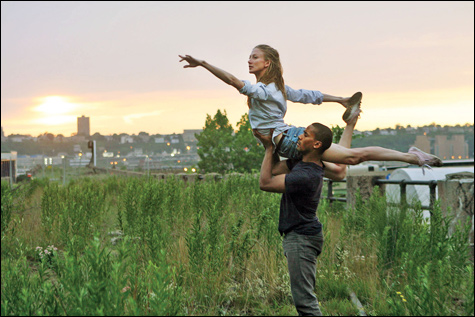
TONY AND MARIA Craig Hall and Rachel Rutherford escape to a dream stage high above the city's dirt and rumble and clash. |
When Jerome Robbins's New York Export: Opus Jazz boogied onto the scene in 1958, it premiered at the Spoleto Festival, then took Europe by storm. Created for Ballets: U.S.A., a company of ballet, modern, and jazz dancers that Robbins had put together for a government-sponsored cultural exchange tour, Opus Jazz was a kind of spinoff from the 1957 hit musical West Side Story, which Robbins directed and choreographed. For Opus Jazz, he removed the tragic characters and storyline and worked with the danced residue of tension, hormonal energy, and democratized classicism. Europeans had never seen anything like it before on a ballet stage.
Ballets: USA lasted three years; then Opus Jazz disappeared until the Joffrey Ballet revived it, in 1974. It made its way into the New York City Ballet repertory in 2005, and that's when two featured dancers, Ellen Bar and Sean Suozzi, got the idea of making it into a site-specific New York film opus. The film, directed by Henry Joost and Jody Lee Lipes, will make its first TV appearance on WGBH's Great Performances this Wednesday (March 24 at 8 pm). It's an abstraction itself, a nostalgic, non-threatening image of an Opus Jazz most of us never experienced first-hand.
The idea was to film each of the ballet's five sections in a different location and make it reflect today's youth. The film doesn't look like a stage performance. Even the choreography for the section actually filmed in a theater, composer Robert Prince's fugal finale with mambo intervention, is fractured by the filmmakers' counter-moves and long shots and editing activities. The outer-borough locations themselves exert a distancing effect on the packed, frenetic street dynamic that charged Robbins's choreography. The dancers spread out luxuriously in an enormous asphalt space next to a forbidding brick structure, an indoor cavern that could be an abandoned pier or parking garage, a gym in anybody's high school.
In between the five sections of the dance, the camera tracks the dancers in their "real lives," but even these glimpses are pensive, mysterious, still, as the dancers wait for trains, kill time, get ready for work.
The choreography looks almost ordinary now, accustomed as we are to dancers in sneakers, sport-derived dance moves, half-serious kid competitions. Some of Robbins's original references seem naively out of date, like the naughty-naughty pelvic bumps that overtake the kids as they pair off in the gym. Do nice girls really lounge about in New York alleys now, and go following strange boys alone into deserted buildings, as Georgina Pazcoguin does? Pazcoguin struts and slinks in front of the guys, inviting trouble, but the scene ends as they reach for her. On stage, the Joffrey men grabbed Pam Nearhoof and threw her into the wings. I remember this as a gang rape.
The 18 New York City Ballet dancers who populate Opus Jazz are long-legged, thin, refined creatures who look beautiful but a little bit out of place in exposed locations. They get the steps right, but they don't seem muscular enough to sink a lay-up or elbow through a crowd.